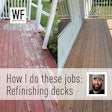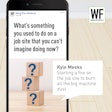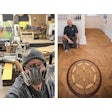Q: I quoted a customer a price for installing a standard No. 1 common white oak floor in his dining room. When I went to do the job, I realized the subfloor was particleboard. He wants me to pay for putting in plywood. I don't think I should. Who's right?
A: Probably the worst mistake contractors make when bidding is giving customers a price over the phone. You have no idea what you're dealing with. For example, you get a call to bid an install for one room. You're really busy, so you don't want to go out to the job. You break down and give the potential customer a price per square foot. Then you go out there to start the job, and it's an entryway and a hall with six doorways. Or, even worse, he included a whole staircase in the square footage. The fact is, you're usually stuck with the bid you made.
Another big mistake contractors make in bidding is they don't inspect the subfloor properly. When there's carpet or linoleum over the subfloor, you need to pull up a corner to see what it is. Some contractors don't make sure it's the proper thickness, or, as in this case, they forget to see if it's particleboard. Even if it is plywood, it may have squeaks. If you don't find them ahead of time, you have to take the time before you install to screw the floor down. If you're aware of these things, you can factor them into your bid and get paid for doing them.
Another thing to check is the floor joist direction. You might plan to do a strip floor in one direction, but when you get down to the subfloor, you realize the joists run the same way. You either have to cover the subfloor with another layer of plywood or lay it on the diagonal — those things are all going to cost you time or money.
Something else to watch out for is subfloor flatness. Carpeting doesn't show uneveness in a subfloor nearly as much as a hardwood floor will, so check it carefully.
Concrete floors also need to be inspected. I once did a job where we checked to see if the subfloor was sealed. We prepared the subfloor and glued down parquet. As it turned out, only the perimeter of the room had been sealed, and the adhesive held everywhere but around the edges. Moisture can be another big problem with concrete. Take all the precautions: Ask if the home owner knows if there's plastic under the slab, check for yard drainage, and ask if there's ever been a water problem. If there's a problem, you'll probably need to get a moisture barrier and put down plywood, and that's time and money you need to know about up front.
If I find pet stains or water stains, I never assume they're going to sand out; I always bid it as a replacement. At best, 10 percent of the time you'll be able sand it out, so always prepare for the worst.
Some things can be costly to overlook while you're bidding the job. After you've been burned once, you won't overlook them anymore. One is not checking the wear layer of the floor. You may end up buying a new wood floor if you sand down all the way to the tongue and groove. Another costly mistake I've made is forgetting to check height differences in a kitchen remodel. On one job, I forgot to make sure there was adequate height for the refrigerator. After the floor went in, the refrigerator wouldn't, and I had to pay to rebuild the cabinet.
Lots of bidding pitfalls come into play when customers assume things are included in the job. For example, on a remodel, the height of the floor may change. Who is responsible for cutting the doors and rehanging them? Who is responsible for removing all the furniture? Is it your responsibility to put in reducers and threshold moldings? Maybe you pulled up carpeting and put in a wood floor, and now there's a gap by the wall. Customers tend to think of baseboard and quarter round as part of the floor, not an extra. Discuss all these things, because contractors often get stuck with them unexpectedly.
Be clear to the customer when you explain what work you'll be doing. If you say you'll use three coats of finish, meaning one sealer and two topcoats, the customer may expect you to come back and do another topcoat, which will cost you extra time and money. Also, be clear about the type of finish you use. For example, some contractors only use oil-modified polyurethane, and they assume that's what the customer expects. If the job is bid for poly and suddenly the customer wants waterbase, that can be a big difference in cost. That's why you need to go over everything, even things you may take for granted.
Something else you may not think of when bidding is the time of day you'll be doing the job. The customer might say you need to be there by 7 a.m., because that's when he leaves for work. You might be paying your guys overtime to be at the job site early; did you put that into your bid?
Lastly, when bidding, give yourself enough time to do the job. If you don't, it can throw you off your whole schedule and cause you to lose your next job. It can also create problems with the home owner. Play it safe and estimate a little more time for the unexpected.































